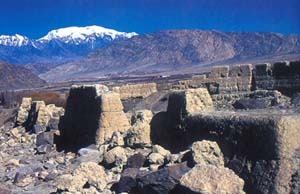|
Kashi Region
( 2005-09-13 )
 Kashi is one of the well-known cities of culture and history in China. Located at the hub of the ancient Silk Road, it was a land of confluence for Sino-foreign cultural exchanges in ancient times, with a long-standing cultural background. Kashi is one of the well-known cities of culture and history in China. Located at the hub of the ancient Silk Road, it was a land of confluence for Sino-foreign cultural exchanges in ancient times, with a long-standing cultural background.
In ancient times, many religions prevailed in Kashgar. The eastward diffusion ofBuddhisminfluenced this place first when Kashgar was one of the first places where Buddhism was believed. After the rise of Islam, this place became a base for this religion in the east of the Pamirs (a high mountain chain mainly in Tajikistan).
Kashi is a land of song and dance whose performing art was spread to the central plains as early as over 1,000 years ago. During the Sui (581-618) and Tang dynasties, Shule music and dance enjoyed a good reputation in Chang'an (modernXi'an). The Twelve Muqam and Sanam, the music and dance that are still popular nowadays, are both bright flowers in the gardenof Chinese arts.
The place is filled with scenic spots and ancient remains.
The Ida Kah Mosque is well known for its grand structure and splendid colors, enjoying a 500-years history since it was built.
The Apak Hoja Mazar is the most attractive one of the numerous Islamic mausoleums. Mahmud Kashgari, who was buried here, is the author of the world classic Grand Turkic Dictionary, which is a rarity in the treasure house of Chinese and world cultural art with a high academic value on the study of languages, literatures, and music in Xinjiang and Central Asia.
The Kashi Sunday Bazaar (country fair) is the biggest country fair in the region, and serves as an ideal place for tourists to experience Kashi's folkways and civic culture.
Kashi is marked by the strong national customs of the Uygur people, who are known to be very hospitable, and good at singing and dancing. Many of the women still wear veils. The people of Kashi are good at handicrafts alongside being famous for their folk songs and dances.
|

